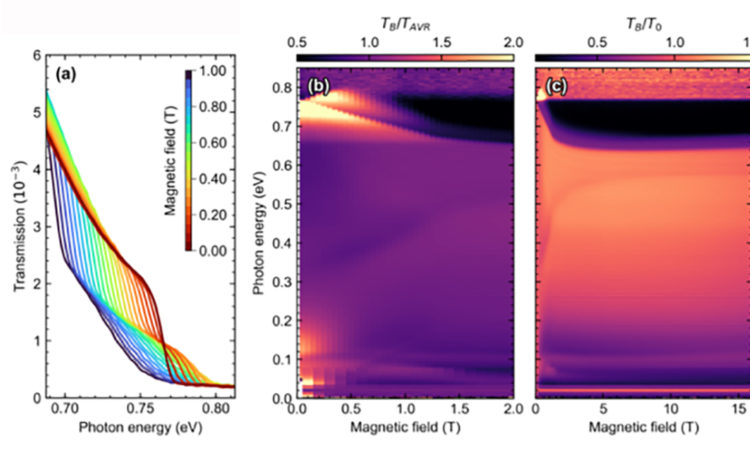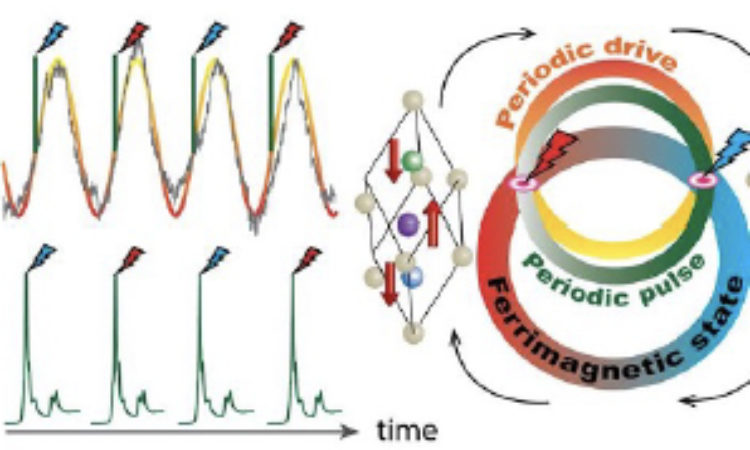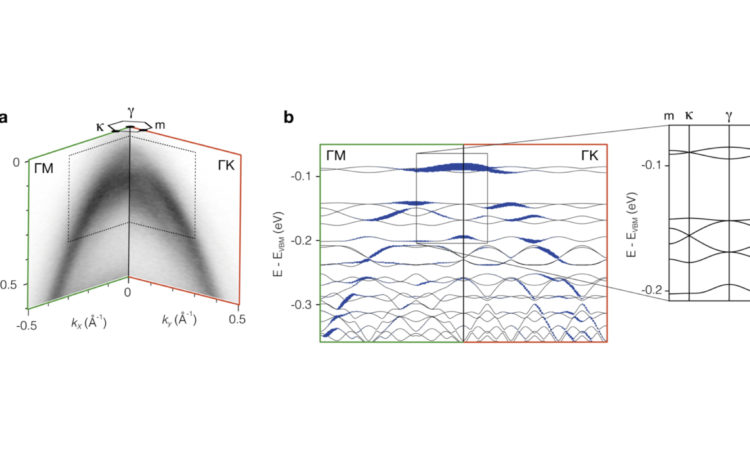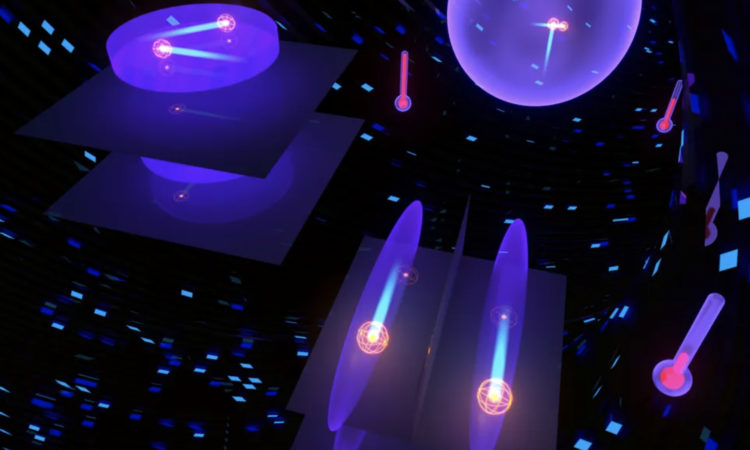From magnetic vortices to magnetic monopoles – ferrotoroidicity as fourth form of ferroic order
Although in many cases nature likes things to be simple and symmetric it is often the asymmetry which leads to exciting new phenomena. Think about life on Earth: It prefers left-handed amino acids to right-handed ones, an asymmetry that is crucial for our existence. In this article authors describe a state in crystals which behaves in an asymmetric way when mirrored in space and time. This so-called ferrotoroidic state consists of atomic magnetic whirls, all cycling in the same direction. A ferrotoroidic material has many properties in common with well-known ferromagnetic materials like iron. But the inherent asymmetry of ferrotoroidic order leads to additional, novel capabilities. For instance, this includes the possibility to control magnetism by electric voltages and vice versa, something with great potential for future applications.


By Manfred Fiebig, Dennis Meier – Department of Materials, ETH Zürich
Based on article published in Nature Communications
The search for novel states of matter and new types of order is one of the most exciting and fundamental aspects of condensed matter physics. Right now, debates are in progress about including an ordered arrangement of uniformly left- or right-handed magnetic vortices as in Fig. 1a to 1c as novel form of ferroic order, termed ferrotoroidicity.
What motivates this association? First of all, “symmetry wants it”. Three forms of long-range order, all with individual transformation properties under space and time inversion, are ferroic. At present, we distinguish ferromagnetism, ferroelectricity, and ferroelasticity. None of these, however, violate space and time inversion simultaneously. Existence of a fourth form of ferroic displaying such twofold symmetry violation is thus compelling — nature is not expected to leave such a void.
Indeed, the multipole expansion of the electromagnetic field potential yields a term that is space- and time-reversal-antisymmetric [1]. The term toroidal moment for this contribution is derived from the toroidal head-to-tail arrangement of spins sketched in Fig. 1a, b that is a simple way to represent it. Toroidal moments are not unheard of. Historically, the observation of parity-violating weak interactions in nuclear physics led to its introduction as anapole moment [2]. In condensed-matter physics, any arrangement of flux closure domains in a ferromagnet represents a toroidal moment.
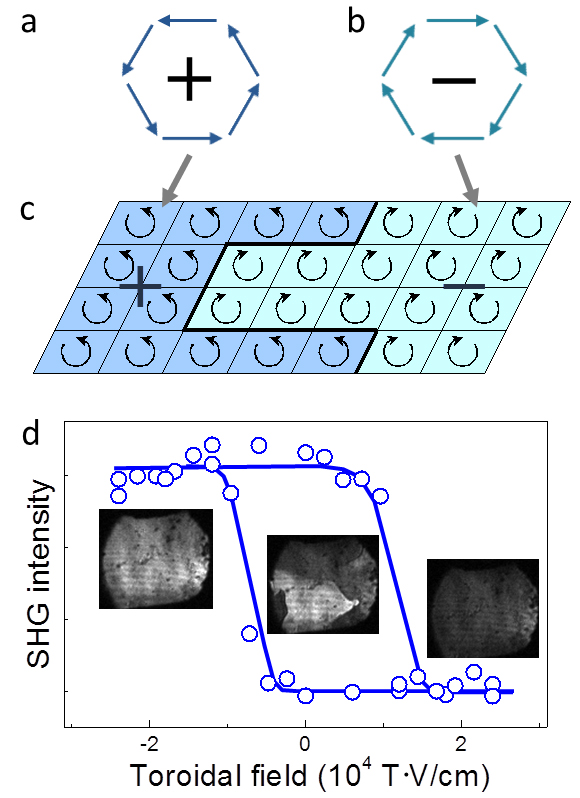
A variety of criteria, however, need to be matched for a state to be called “ferroic” [3]. Spontaneous uniform alignment of some property at a critical temperature is one requirement. It is, for instance, fulfilled in LiCoPO4 where neutron diffraction revealed the emergence of a toroidal spin order at 21.8 K [4].
Furthermore, a ferroic should yield at least two different domain states, such as the regions with counterclockwise (+) and clockwise (-) head-to-tail arrangement of spins, respectively, in Figs. 1a and 1b. In LiCoPO4 domain patterns of this type were imaged by second harmonic generation (SHG), a process that doubles the frequency of a light wave sent into a material with sensitivity to the different spin orientations in the domain states associated to Figs. 1a and 1b [5]. The possibly most outstanding property identifying a ferroic state is its hysteresis. It expresses the ability to switch between different domain states by a conjugate external field. In a ferrotoroidic material the conjugate field violates space- and time-inversion symmetry, and such a toroidal field was used in a recent MaNEP publication [6] to obtain a hysteresis of purely ferrotoroidic origin. SHG was used for recording this hysteresis and image the progressing ferrotoroidic domain pattern throughout the poling process.
This experiment is an important consolidation of ferrotoroidicity as the fourth form of ferroic order. Live would be boring, though, if there were no open questions to be addressed. First, a state as in Fig.1 may still be interpreted as antiferromagnetic with the toroidal moment just as a side effect that might, in principle, not even lead to a measurable property. We thus need to show that the interaction between the toroidal moments can be the primary source of the long-range order. Second, access to the toroidal state is presently unsatisfyingly indirect. Since we cannot generate a toroidal field, we are coupling to it by applying orthogonal magnetic and electric fields which violates symmetries in the way as the toroidal field. Likewise, we do not detect a toroidal moment directly, but via certain components of the magnetoelectric effect associated to it (analogous to detecting a ferroelectric polarization via the associated piezoelectric effect).
Finally, note what happens if the spins in Fig. 1a, b are all rotated by 90°. They would all point towards or away from a central point which is just the unit-cell equivalent of a magnetic monopole. This duality between toroidal moments and magnetic monopoles is striking – and entirely unexplored!
[1] N. A. Spaldin, M. Fiebig, M. Mostovoy, J. Phys.: Condens. Matter 20, 434293 (2008)
[2] C. S. Wood, S. C. Bennett, D. Cho, B. P. Masterson, J. L. Roberts, Roberts, C. E. Tanner, C. E. Wieman, Science 275, 1759 (1997)
[3] V. K. Wadhavan, Introduction to ferroic materials, (Gordon and Breach, 2000)
[4] D. Vaknin, J. L. Zarestky, L. L. Miller, J.-P. Rivera, H. Schmid, Phys. Rev. B 65, 224414 (2002)
[5] B. B. van Aken, J.-P. Rivera, H. Schmidt, M. Fiebig, Nature 449, 702 (2007)
[6] A. S. Zimmermann, D. Meier, M. Fiebig, Nature Comm. 5, 4796 (2014)
